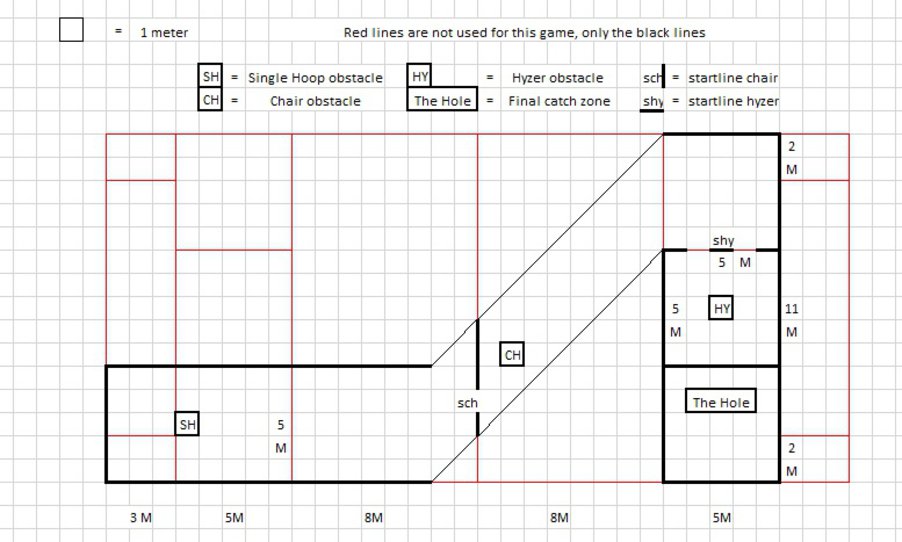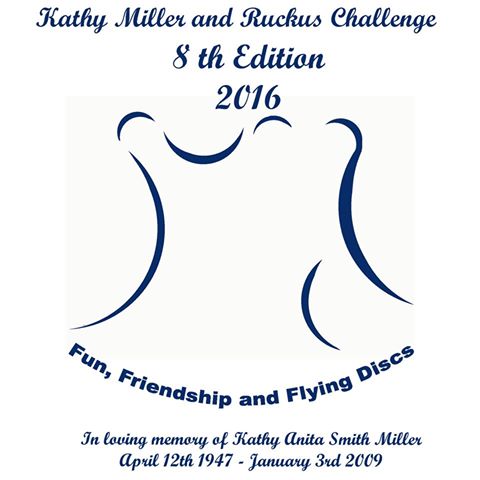Games and Rules in the 8th KMARCh 2016
This section provides an overview on the different games we'll be playing on the 8th edition of KMARCh and briefly explains the rules and calculation. You can pick individual games, but our recommendation is to subscribe to all. Not only are they big fun, but every single one of them is challenging in a different specific aspect and you know that for the first 3 players of the overall the Golden Ticket for the finals will be waiting. Oh and remember: All games can as well be played with two handlers and one dog in the dual-league
Bottleneck D/A
Teams will get a 60 second timeframe to score as many points as possible, all throws will be scored. The layout of the field resembles a double Whisky bottle (crystal) with a "cork" on the top (drawing below). Something new is that teams can choose from which end they select to throw. This choice is made when entering the field and cannot change during the game. To obtain a score, the dog must catch or land after a successful catch at least with 1 paw in or on the line of a scoring zone. When this paw is in the 1st zone (0 - 3 M): 0 points, 2nd zone (3 - 8 M): 1/1.5 point, 3rd zone (8 - 16 M): 2/2.5 points, 4th zone (16 - 24 M): 3/3.5 points, cork (24 - 29 M): 5/5.5 points, cap (29 - 32 M): 7/7.5 points. One paw within or on the sidelines of the bottle will allow the judges to validate the catch. The airborne catch will make the score for that throw go half a point higher. Time starts when the first disc is put in flight for the dog to catch. Countdown is 60 secs; 30 secs; 10 secs, 5,4,3,2,1, time
Discs: Any canine disc can be used. Rollers count for puppies and older dogs, it's not the release that counts, it's the catch.For Duo League Bottleneck, both handlers throws one after the other. None of the both handlers throw two consecutive discs. It doesn't matter which handler retrieves the disc.

Dog-Y-O-Drift
The object of this game is to successfully catch 3 disc and return over the startline with disc, dog and handler in the fastest time possible. However, a specific path must be followed. The first disc is thrown from the Startline over the Finish line, the handler now follows the dog to the finish line. The second throw is made from the Finish line over the Startline and again the handler follows the dog. The last throw is from the Startline accross the Finish line but this time the handler remains at the Startline. Time is stopped when all 3 members of the team cross the Startline. In order to continue to the next throw, the dog must successfully catch the disc. If the disc is not caught, the throw has to be repeated until a catch is made. Any lure of any kind is allowed to recall the dog (towel, ball, treats, disc, etc. .). If this lure is a disc, the same disc has to be thrown throughout the entire duration of the game. The second disc can only be used as a lure and not as a second disc to throw.
For Duo League, both handlers throw one after the other. None of the both handlers throws two consecutive discs. It doesn't matter which handler retrieves the disc.
Maximum time is 60", however do think about the fact this is a timed game. Time begins at the first throw made for the dog to catch.

Obstacle Course
Obstacle Course is an obstacle run shaped as the green on a golf course. As you can see on the picture below, the course runs from the startline to the scoring zone (in golf it would be a hole, but that's a little dangerous for dogs so it's a marked area). It is layed out within the Bottleneck field. There are at least 3 obstacles set up along the course. These are the same in all the legs and in particular order, the single hoop, the chair and the hyzer. (building plans are provided by the organization) Before each obstacle a landing zone is established where the dog has to land before the handler can tackle the obstacle itself. The object of the game is to arrive at the final scoring zone in the least throws possible. The first throw is made at the starting line and then the next throws are made from the point where the dog has caught the disc.
If an obstacle is not passed within 3 throws, the handler can make a 4th throw from the start point but he/she is allowed to bypass the obstacle.
If the catch is made outside the bounds of the course (within the reknown KMARCh-spririt of course), the throw will not be counted as valid and the team has to back to their last starting point and try again.
Pups can bypass obstacle 1 and 3 after only 1 attempt, only by using the roller throw as a bypass. If the handler wants to continue with regular throws, the obstacle must be cleared.
For Duo League, both handlers throw one after the other. None of the both handlers throws two consecutive discs. It doesn't matter which handler retrieves the disc.

Freestyle and Shortstyle
The stage is yours. Accessories are allowed as long as it doesn't impair the dog to move freely or get hurt due to these accessories. Time limit is 90 seconds for freestyle and 60 seconds for shortstyle. In Shortstyle there will be a surprise which will be announced at the players meeting. The number of discs you can use is not limited. Feel free to bring out all the discs you have, if you can handle it. Only condition is that you have to use (in one way or another, not necessarily throw them; you can stack them and have the dog leap over). Time starts as the first disc leaves the hand with the intent for the dog to catch it. This doesn't mean you will not be scored from the moment you step on the field. The most important criteria are the tail of the dog and the smile of the handler. Countdown is (60 secs), 30 secs, 10 secs, time
Judges will mark the performance with a figure from 0 to 10, using 0,25 point increments. The abreviations are D O G S for freestyle solo; C - D O G S for pairs freestyle. Drive: How far will the dog go to get that disc? Going for the airborne catch? How bad is he into it? Are his landings good and is the handler matching the efforts of the dog to make the team look the best they can. Over-acting: When you look at the player and the dog from the second they enter the field, what are they telling you? Does the handler look happy or is he just doing his routine as every other day? Is the dog's tail wagging, or is he only doing it because he has to? Are they having fun yet? Who's taking the credit, handler or dog? Also the entertainment value of the routine will be scored as well as the difficulty relative to the size and the competences of the team. Good moves: tried once, tried again. or quit while ahead, field use (how do they move across the field), lucidity and rebound ability (e.g. use of a roller when stuck or lost and then continue), new or renewed moves and creativity of the handler Structure: flow and structure of the entire routine, is it an incoherent succession of throws or is there a flow in it? Also look at disc management in this category. (e.g. having the dog wait and sit for way too long before executing a vault) For pairs routines there is one more: Coordination how do the handlers move and work together during the routine, picking up discs for each other, throwing to each other, moves with the three players involved

 Andrew Lindley
Andrew Lindley
 Kurt Spohner
Kurt Spohner